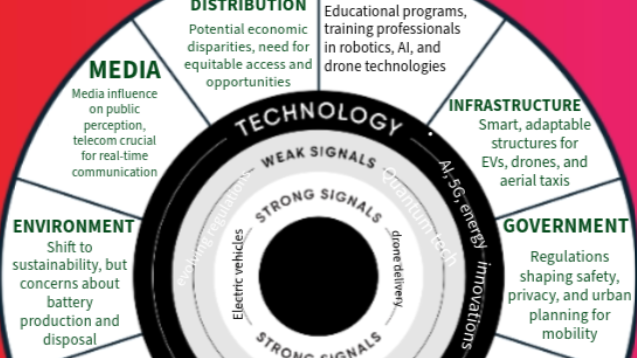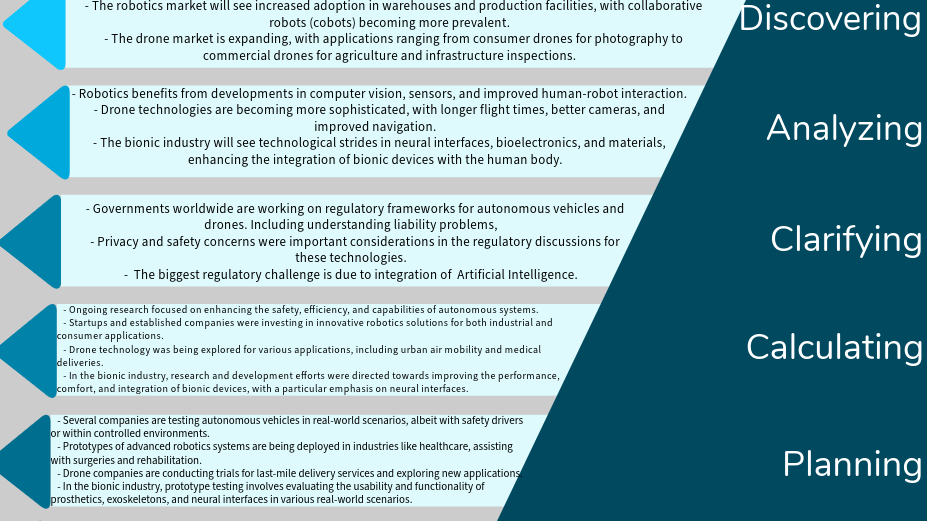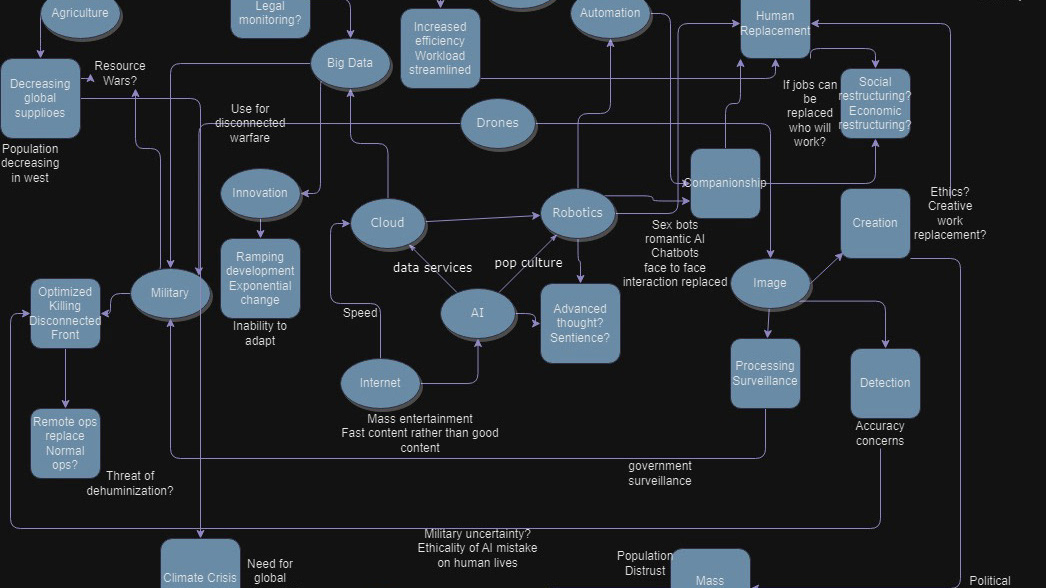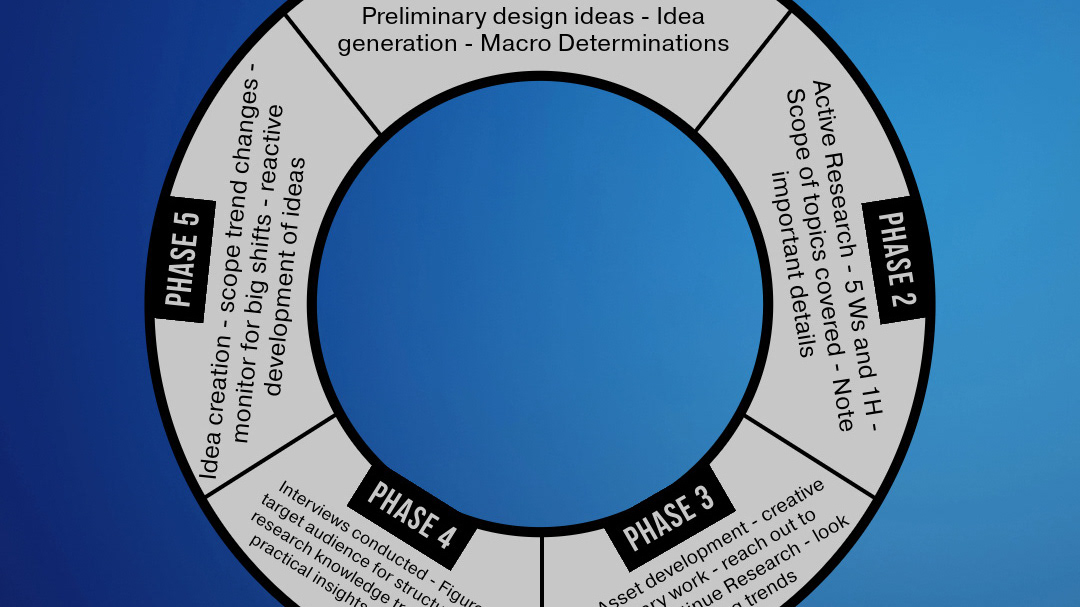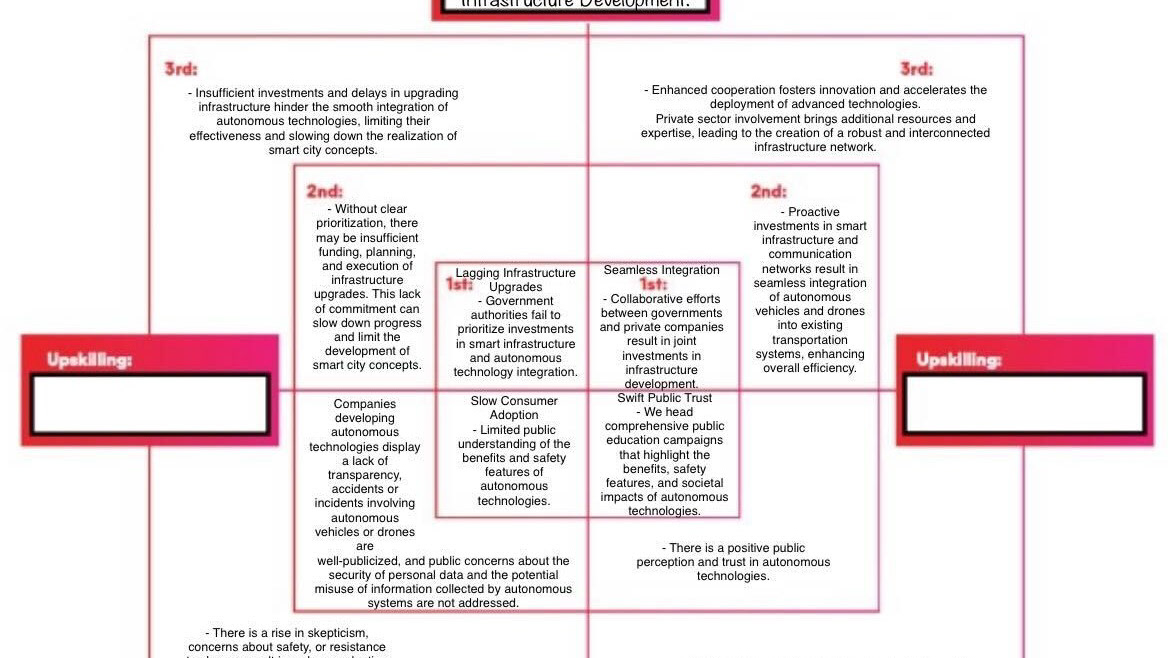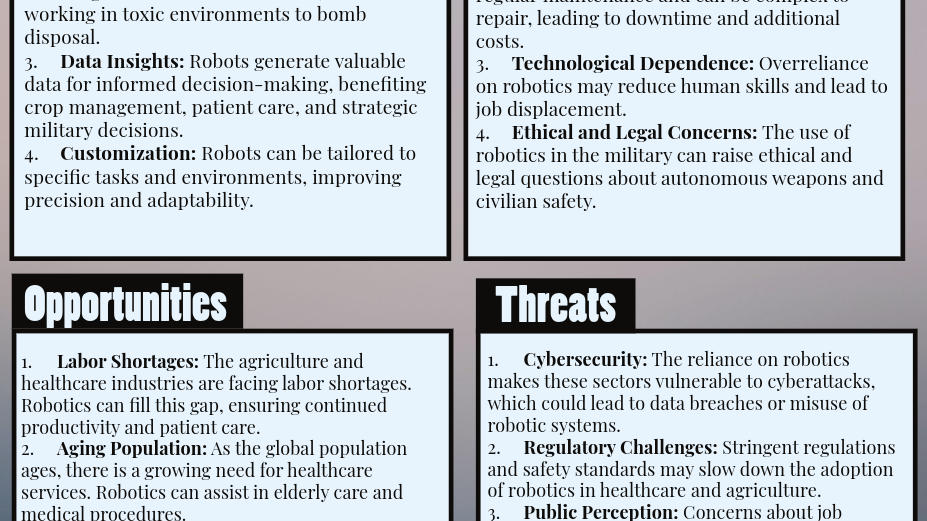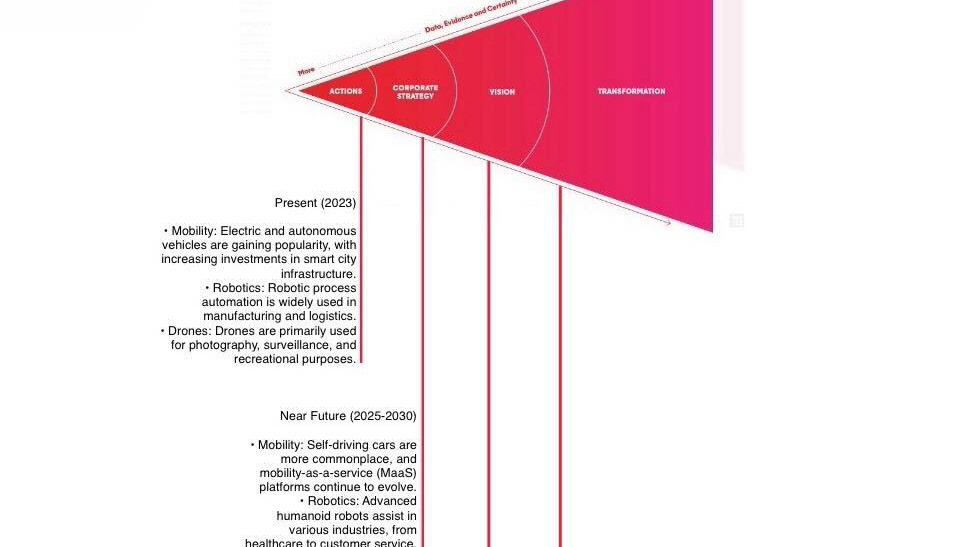Annabelle Raukete
----
Contradictions:
- Contradiction 1: The rise of self-driving cars vs. concerns about job displacement. As autonomous vehicles become more prevalent, there is a contradiction between the potential for increased safety and efficiency and the concerns about job losses in traditional transportation sectors.
- Contradiction 2: Integration of bionics in mobility robotics vs. ethical considerations. While the integration of bionics can enhance the performance of mobility robots, ethical questions arise about the potential for creating "superhuman" capabilities and the fair distribution of such technologies.
- Contradiction 3: Growing demand for drone delivery services vs. airspace congestion. The increasing popularity of drone deliveries poses a contradiction in managing airspace congestion and ensuring safe coexistence with traditional air traffic.
- Contradiction 1: The rise of self-driving cars vs. concerns about job displacement. As autonomous vehicles become more prevalent, there is a contradiction between the potential for increased safety and efficiency and the concerns about job losses in traditional transportation sectors.
- Contradiction 2: Integration of bionics in mobility robotics vs. ethical considerations. While the integration of bionics can enhance the performance of mobility robots, ethical questions arise about the potential for creating "superhuman" capabilities and the fair distribution of such technologies.
- Contradiction 3: Growing demand for drone delivery services vs. airspace congestion. The increasing popularity of drone deliveries poses a contradiction in managing airspace congestion and ensuring safe coexistence with traditional air traffic.
Inflections:
- Inflection 1: Breakthroughs in swarm robotics for precision agriculture. Advancements in swarm robotics could be a key inflection point, transforming the efficiency and scalability of precision agriculture through coordinated drone swarms for crop monitoring and management.
- Inflection 2: Mainstream adoption of self-driving cars for public transportation. The widespread acceptance and integration of self-driving cars into public transportation systems could be a transformative inflection, reshaping urban mobility and reducing reliance on traditional transit modes.
- Inflection 3: Evolution of bionic interfaces for human-robot collaboration. Significant progress in bionic interfaces that seamlessly integrate with human capabilities could mark an inflection, fostering new forms of collaboration between humans and robots in various industries.
- Inflection 1: Breakthroughs in swarm robotics for precision agriculture. Advancements in swarm robotics could be a key inflection point, transforming the efficiency and scalability of precision agriculture through coordinated drone swarms for crop monitoring and management.
- Inflection 2: Mainstream adoption of self-driving cars for public transportation. The widespread acceptance and integration of self-driving cars into public transportation systems could be a transformative inflection, reshaping urban mobility and reducing reliance on traditional transit modes.
- Inflection 3: Evolution of bionic interfaces for human-robot collaboration. Significant progress in bionic interfaces that seamlessly integrate with human capabilities could mark an inflection, fostering new forms of collaboration between humans and robots in various industries.
Practices:
- Practice 1: Implementation of bionics in medical mobility robots. The healthcare industry could witness a practice where bionics is routinely integrated into medical robots, aiding in surgeries, rehabilitation, and providing enhanced mobility assistance for patients.
- Practice 2: Adoption of autonomous drones for crop management. The agricultural sector may adopt practices involving the routine use of autonomous drones for tasks such as planting, monitoring, and harvesting, contributing to more sustainable and precise farming methods.
- Practice 3: Integration of self-driving cars in smart city planning. Cities might adopt practices that involve the seamless integration of self-driving cars into urban planning, leading to smarter and more efficient transportation systems.
- Practice 1: Implementation of bionics in medical mobility robots. The healthcare industry could witness a practice where bionics is routinely integrated into medical robots, aiding in surgeries, rehabilitation, and providing enhanced mobility assistance for patients.
- Practice 2: Adoption of autonomous drones for crop management. The agricultural sector may adopt practices involving the routine use of autonomous drones for tasks such as planting, monitoring, and harvesting, contributing to more sustainable and precise farming methods.
- Practice 3: Integration of self-driving cars in smart city planning. Cities might adopt practices that involve the seamless integration of self-driving cars into urban planning, leading to smarter and more efficient transportation systems.
Hacks:
- Hack 1: DIY modifications for enhancing drone capabilities. Enthusiasts and hobbyists may engage in DIY modifications to improve the performance of consumer drones, pushing the boundaries of their capabilities for recreational and experimental purposes.
- Hack 2: Adaptive use of self-driving car technology in unconventional vehicles. Innovators might explore hacks by adapting self-driving car technology for use in unconventional vehicles, such as autonomous delivery robots or mobile service platforms.
- Hack 3: Creative applications of bionics in robotic art projects. Artists and researchers could engage in hacks by creatively applying bionic technologies in robotic art projects, exploring the intersection of technology and artistic expression.
- Hack 1: DIY modifications for enhancing drone capabilities. Enthusiasts and hobbyists may engage in DIY modifications to improve the performance of consumer drones, pushing the boundaries of their capabilities for recreational and experimental purposes.
- Hack 2: Adaptive use of self-driving car technology in unconventional vehicles. Innovators might explore hacks by adapting self-driving car technology for use in unconventional vehicles, such as autonomous delivery robots or mobile service platforms.
- Hack 3: Creative applications of bionics in robotic art projects. Artists and researchers could engage in hacks by creatively applying bionic technologies in robotic art projects, exploring the intersection of technology and artistic expression.
Extremes:
- Extreme 1: Bio-integrated mobility units. Researchers may explore extreme concepts involving the integration of bionic elements directly into mobility units, creating bio-hybrid systems that combine biological and robotic components for enhanced performance.
- Extreme 2: Quantum-inspired optimization for drone swarms. In an extreme scenario, researchers might investigate the application of quantum-inspired algorithms to optimize the coordination and efficiency of large-scale drone swarms, pushing the boundaries of swarm robotics in agriculture.
- Extreme 3: Self-sustaining robotic ecosystems. An extreme idea could involve the development of self-sustaining robotic ecosystems, where drones, robots, and autonomous vehicles collaborate in a highly integrated manner to perform tasks autonomously without external intervention.
- Extreme 1: Bio-integrated mobility units. Researchers may explore extreme concepts involving the integration of bionic elements directly into mobility units, creating bio-hybrid systems that combine biological and robotic components for enhanced performance.
- Extreme 2: Quantum-inspired optimization for drone swarms. In an extreme scenario, researchers might investigate the application of quantum-inspired algorithms to optimize the coordination and efficiency of large-scale drone swarms, pushing the boundaries of swarm robotics in agriculture.
- Extreme 3: Self-sustaining robotic ecosystems. An extreme idea could involve the development of self-sustaining robotic ecosystems, where drones, robots, and autonomous vehicles collaborate in a highly integrated manner to perform tasks autonomously without external intervention.
When creating the "CIPHER" graphic, I used AI to find the ideas that would be a part of the actual cipher. I made a document at first and had a lot more ideas than I would ever be able to fit into a cohesive graphic. I asked ChatGPT to summarize each of the larger segments of the cipher into a single statement. After finding those, I tried to figure out how to visualize this. I decided to use my graphic design skills and the Adobe Creative campus. it took some time for me to get it just right but I believe it portrays things well.
